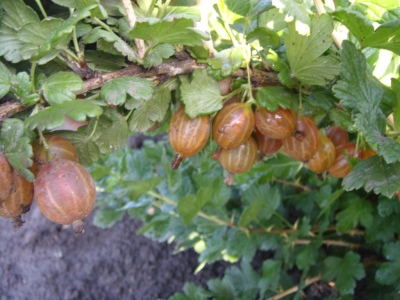
- Authors: Finland
- Name synonyms: Hinnonmainen punainen, Ribes uva-crispa Olavi
- Year of approval: 1999
- Growth type: medium-sized
- Description of the bush: slightly spreading, dense, spherical
- Escapes: straight, directed upwards and to the sides, of medium thickness; growing - green, without pubescence, lignified - light gray
- Thorniness: strong
- Thorns: one- and two-part, of medium length and short, sharp, with a straight apex, light-colored
- Sheet: 3-5-lobed, medium-sized, green, without pubescence, delicate consistency, with a low sheen, concave along the main veins on the growing shoot and straight on the fruiting shoot
- Spike location: located along the entire length of the shoot, directed perpendicular to the shoot; the largest cluster of thorns - at the base of the bush
Gooseberry is a healthy and tasty berry that many summer residents grow on their plots. Among the many classic and recently bred species, the mid-late Olavi of Finnish selection is of great interest.
Breeding history
Olavi is the result of the efforts of Finnish breeders. The berry culture was bred more than 20 years ago. The main task of the scientists was to create a variety that can grow and bear fruit in unfavorable climatic conditions. Olavi's gooseberry was added to the State Register of allowed for use on the territory of the Russian Federation in 1999. The variety is recommended for cultivation in the North-West and North regions.
Description of the variety
The mid-late type Olavi is a medium-sized semi-spreading spherical shrub with a strong crown thickening with green leaves. The bush grows up to 150 cm in height. The plant is characterized by upright shoots of medium thickness, heavily covered with sharp one / two-part thorns, and small brown buds growing slightly deflected. During the flowering period, the shrubs are covered with small bell flowers of a pale color.
Olavi is a highly self-fertile crop (up to 46%), so there is no need to plant pollinating shrubs.
Characteristics of berries
The gooseberry is a medium-fruited species. Berries gain weight from 2 to 4.4 g. Gooseberries grow in regular shape - oval or round-oval with a smooth waxy surface without edges. Ripe berry has a beautiful uniform color - dark cherry with pronounced light streaks. The peel of the berries is thin but firm.
Gooseberries tolerate transportation well within 3 days after picking, do not crack, and can also be stored in a cool place for up to 5-6 days. Berries have a universal purpose - they are eaten fresh, used in cooking, frozen, processed into preserves, marmalades, jams and compotes.
Taste qualities
The gooseberry tastes excellent. The pulp is fleshy, tender, fine-grained and very juicy. The taste is dominated by sourness, diluted with light sweetness. The aroma of the berries is barely noticeable, but the taste is very refreshing. The pulp contains almost 12% sugars and less than 4% acids.
Ripening and fruiting
Olavi is a medium late ripening crop. The first harvest can be observed already in the second year after planting. The variety is characterized by stable fruiting for 20 years. You can taste the berries from mid-August.
Yield
Highly productive variety. With standard agricultural technology, from 1 bush per season, you can collect from 7 to 13 kg of delicious berries.Growing gooseberries on an industrial scale, you can count on 55 centners of berries per hectare.
Landing
Planting dates directly depend on the climate of the region. In the northern part, planting of seedlings is carried out in the spring, after the soil has warmed up well, but the buds have not yet swollen. In the southern strip, you can plant seedlings in the fall (October) - 30-45 days before stable frosts. When planting, it is important to observe the distance between seedlings - 150-200 cm. A seedling with 2-3 shoots 25-30 cm high and a developed root system is healthy for planting. It is optimal to plant two-year-old bushes.

Growing and caring
This variety is easy to care for, but a little picky about growing conditions. The site should be well lit by the sun, protected from gusty winds, drafts and stagnant moisture (deep passage of groundwater is recommended). The best is considered to be loose, fertile, loamy or sandy loam soil with a neutral level of acidity. You can get your gooseberry seedlings in several ways - by layering or cuttings.
The gooseberry agrotechnics is standard - moderate watering, fertilization, sanitary pruning of branches, formation of the crown of a bush, weeding and mulching of the near-root zone, prevention of diseases and pest infestations. In harsh winters, agrofibre shelter may be necessary.



Disease and pest resistance
Gooseberries have excellent immunity, allowing them to resist many diseases and pests. He is not exposed to American powdery mildew and spherotec, and also rarely suffers from anthracnose and septoria. Timely treatments, as well as proper care, will help protect against pest infestation.

In order for the gooseberry to produce a good harvest, it is necessary to devote time to disease prevention.
Resistance to adverse climatic conditions
The gooseberry has excellent stress resistance, so it quickly adapts to the most adverse weather conditions. The culture is frost-resistant (up to -30 degrees), tolerates heat and light shade. Prolonged drought and drafts are undesirable for the plant.




































































